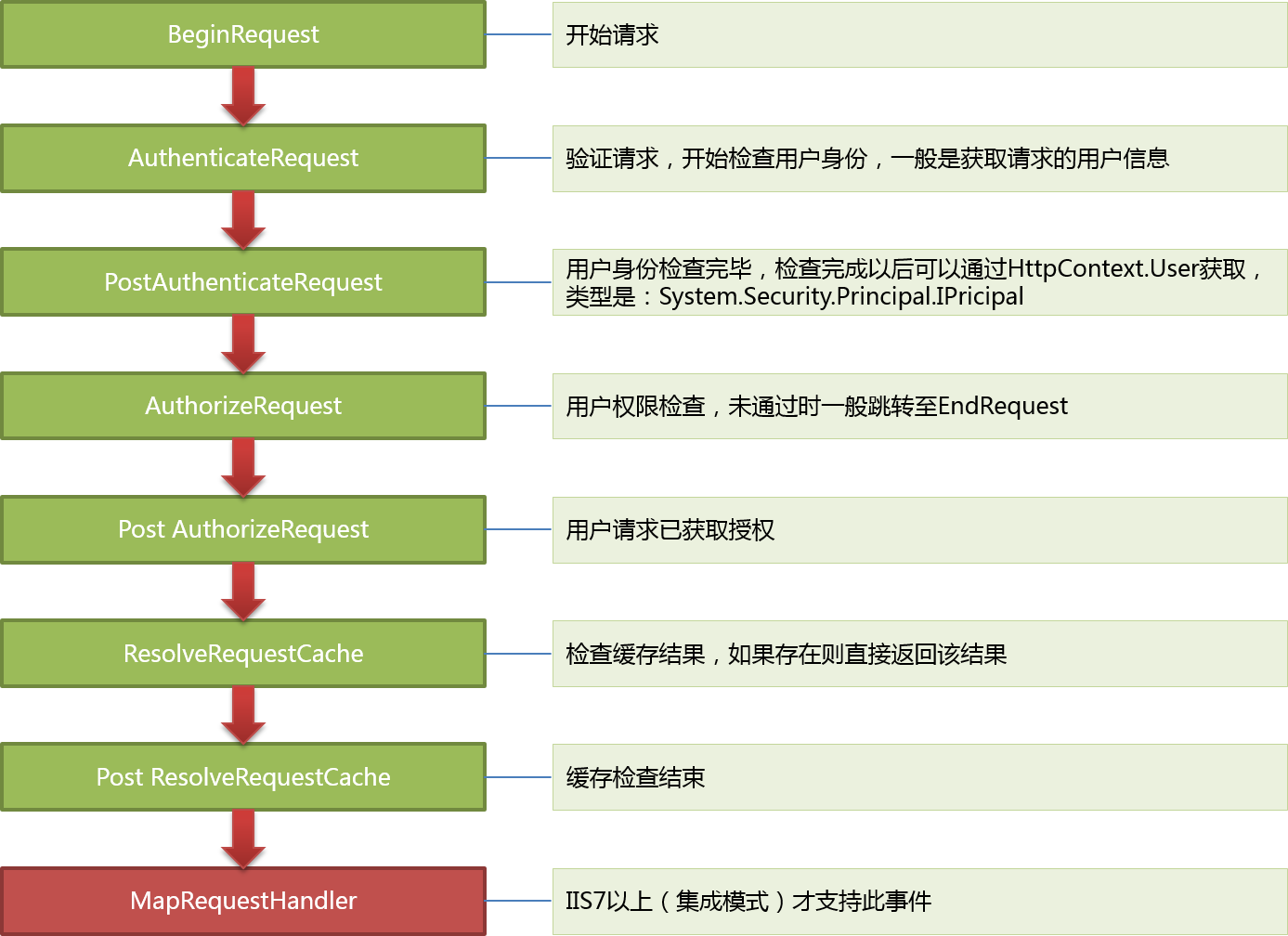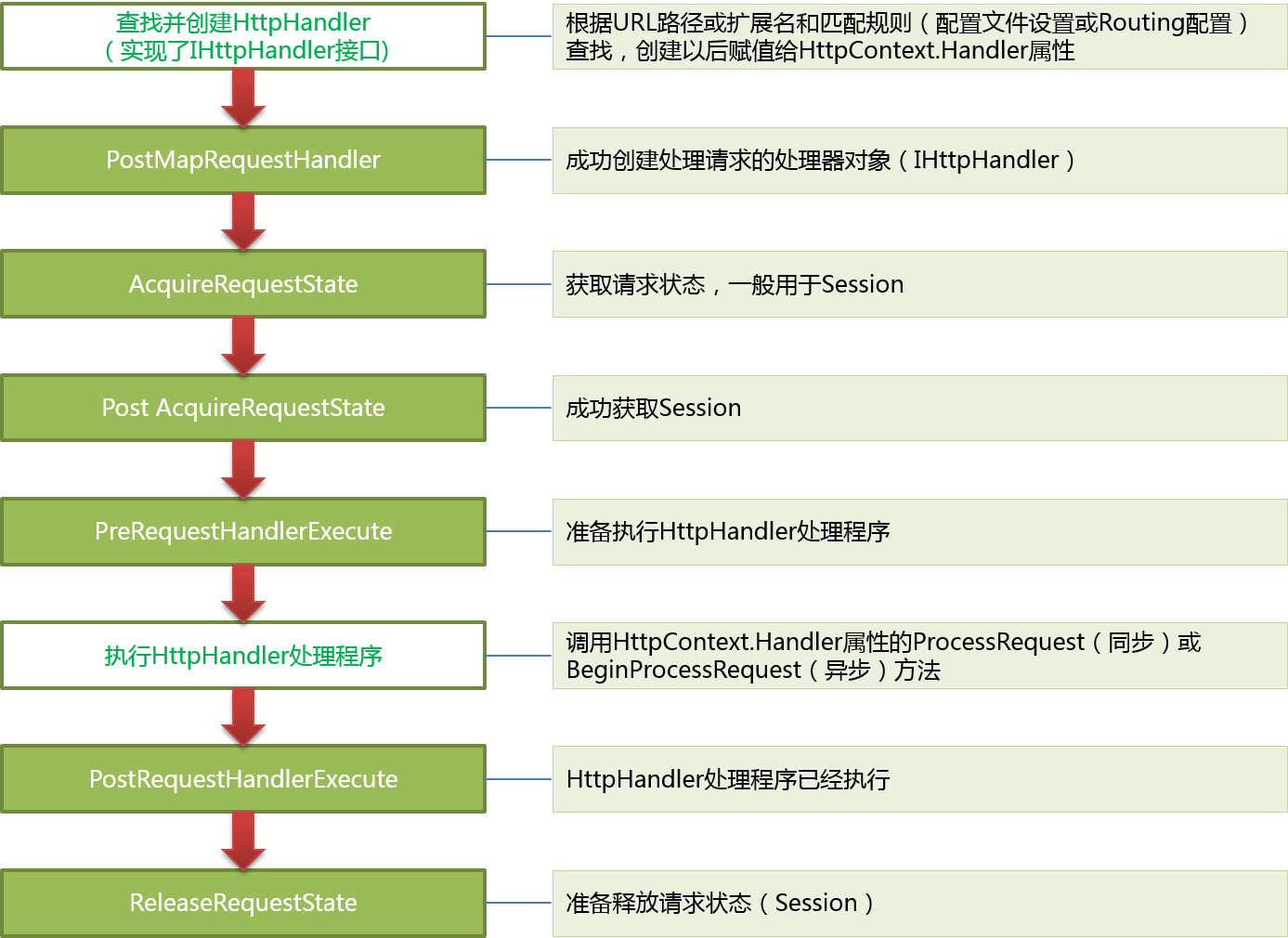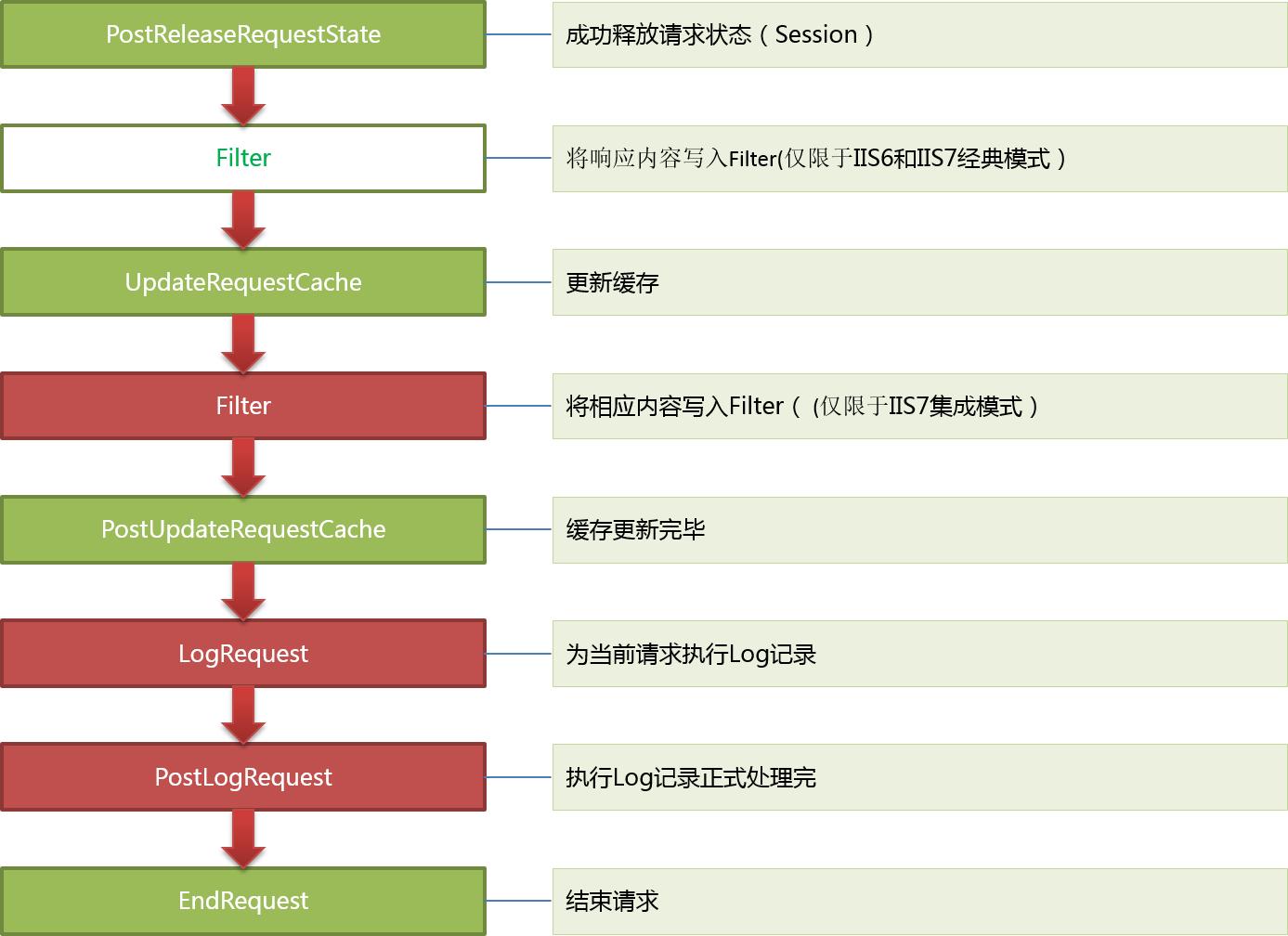接上一篇, 我在 HttpModule 的Init方法中, 添加了自己的事件, 在Pipeline里, 就会把握注册的事件给执行了. 那么Pipeline是如何执行并且按照什么顺序执行的呢?
现在我们重新回到HttpApplication.InitInternal()方法中来. 注: Integrated 是集成的意思, 明白这个单词的意思之后, 下面这几句代码就很好理解了.
if (HttpRuntime.UseIntegratedPipeline) { this._stepManager = new PipelineStepManager(this); //集成 } else { this._stepManager = new ApplicationStepManager(this); //经典 } this._stepManager.BuildSteps(this._resumeStepsWaitCallback);
集成模式和经典模式(或IIS6)使用的是不同的StepManager,这个类的BuildSteps方法就是为了创建有序的ExecutionStep,其中包括各种事件的事情以及其它在各时间周期之间穿插的操作,最主要的操作,大家以前就应该知道的,比如哪个周期可以判定使用哪个HttpHandler,以及在哪个周期内执行这个HttpHandler的BeginProcessRequest方法。
1. 经典模式
由于不同的StepManager处理方式不同,我们先看经典模式的处理代码:
//HttpApplication的内部类ApplicationStepManager internal override void BuildSteps(WaitCallback stepCallback) { ArrayList steps = new ArrayList(); HttpApplication app = base._application; bool flag = false; UrlMappingsSection urlMappings = RuntimeConfig.GetConfig().UrlMappings; flag = urlMappings.IsEnabled && (urlMappings.UrlMappings.Count > 0); steps.Add(new HttpApplication.ValidateRequestExecutionStep(app)); steps.Add(new HttpApplication.ValidatePathExecutionStep(app)); if (flag) { steps.Add(new HttpApplication.UrlMappingsExecutionStep(app)); //Url Mapping } app.CreateEventExecutionSteps(HttpApplication.EventBeginRequest, steps); app.CreateEventExecutionSteps(HttpApplication.EventAuthenticateRequest, steps); app.CreateEventExecutionSteps(HttpApplication.EventDefaultAuthentication, steps); app.CreateEventExecutionSteps(HttpApplication.EventPostAuthenticateRequest, steps); app.CreateEventExecutionSteps(HttpApplication.EventAuthorizeRequest, steps); app.CreateEventExecutionSteps(HttpApplication.EventPostAuthorizeRequest, steps); app.CreateEventExecutionSteps(HttpApplication.EventResolveRequestCache, steps); app.CreateEventExecutionSteps(HttpApplication.EventPostResolveRequestCache, steps); steps.Add(new HttpApplication.MapHandlerExecutionStep(app)); //Handle Mapping app.CreateEventExecutionSteps(HttpApplication.EventPostMapRequestHandler, steps); app.CreateEventExecutionSteps(HttpApplication.EventAcquireRequestState, steps); app.CreateEventExecutionSteps(HttpApplication.EventPostAcquireRequestState, steps); app.CreateEventExecutionSteps(HttpApplication.EventPreRequestHandlerExecute, steps); steps.Add(app.CreateImplicitAsyncPreloadExecutionStep()); steps.Add(new HttpApplication.CallHandlerExecutionStep(app)); //execute handler app.CreateEventExecutionSteps(HttpApplication.EventPostRequestHandlerExecute, steps); app.CreateEventExecutionSteps(HttpApplication.EventReleaseRequestState, steps); app.CreateEventExecutionSteps(HttpApplication.EventPostReleaseRequestState, steps); steps.Add(new HttpApplication.CallFilterExecutionStep(app)); //Filtering app.CreateEventExecutionSteps(HttpApplication.EventUpdateRequestCache, steps); app.CreateEventExecutionSteps(HttpApplication.EventPostUpdateRequestCache, steps); this._endRequestStepIndex = steps.Count; app.CreateEventExecutionSteps(HttpApplication.EventEndRequest, steps); steps.Add(new HttpApplication.NoopExecutionStep()); this._execSteps = new HttpApplication.IExecutionStep[steps.Count]; steps.CopyTo(this._execSteps); this._resumeStepsWaitCallback = stepCallback; }
接着来看一下上面标红的那个方法:
private void CreateEventExecutionSteps(object eventIndex, ArrayList steps) { AsyncAppEventHandler handler = this.AsyncEvents[eventIndex]; if (handler != null) { handler.CreateExecutionSteps(this, steps); } EventHandler handler2 = (EventHandler) this.Events[eventIndex]; if (handler2 != null) { Delegate[] invocationList = handler2.GetInvocationList(); for (int i = 0; i < invocationList.Length; i++) { steps.Add(new SyncEventExecutionStep(this, (EventHandler) invocationList[i])); } } }
HttpApplication.EventBeginRequest 作为一个object的参数传入这个方法了, 并且从这个方法里面看, 它被当做了一个Key值来用. 那么他具体是个啥呢? 去HttpApplication中看一下.
private static readonly object EventBeginRequest; static HttpApplication() { _dynamicModuleRegistry = new DynamicModuleRegistry(); ...... EventBeginRequest = new object(); ...... AutoCulture = "auto"; _moduleIndexMap = new Hashtable(); }
从这里能看到, 他真的就是一个object 类型的Key.
看着上面的代码是不是有似曾相识的感觉,很多讲声明周期的文章都会提到20多个的事件(BeginRequest, EndRequest等),我们来看看这个方法的完整功能都是做了什么,归纳总结有5点:
- 对请求的Request进行验证,ValidateRequestExecutionStep。
- 对请求的路径进行安全检查,禁止非法路径访问(ValidatePathExecutionStep)。
- 如果设置了UrlMappings, 进行RewritePath(UrlMappingsExecutionStep)。
- 执行事件处理函数,比如将BeginRequest、AuthenticateRequest转化成可执行ExecutionStep在正式调用时候执行。
- 在这18个事件操作处理期间,根据不同的时机加了4个特殊的ExecutionStep。
- MapHandlerExecutionStep:查找匹配的HttpHandler
- CallHandlerExecutionStep:执行HttpHandler的BeginProcessRequest
- CallFilterExecutionStep:调用Response.FilterOutput方法过滤输出
- NoopExecutionStep:空操作,留着以后扩展用
需要注意的是所有的ExecuteionStep都保存在ApplicationStepManager实例下的私有字段_execSteps里,而HttpApplication的BeginProcessRequest方法最终会通过该实例的ResumeSteps方法来执行这些操作(就是我们所说的那些事件以及4个特殊的Steps)。
2. 集成模式
好像在记忆里, 我发布的项目都是集成模式的. 那在这里来看一下集成模式是怎么执行的.
//HttpApplication 的内部类 PipelineStepManager
internal override void BuildSteps(WaitCallback stepCallback) { HttpApplication app = base._application;
//add special steps that don't currently
//correspond to a configured handler HttpApplication.IExecutionStep step = new HttpApplication.MaterializeHandlerExecutionStep(app);
//implicit map step app.AddEventMapping("ManagedPipelineHandler", RequestNotification.MapRequestHandler, false, step);
app.AddEventMapping("ManagedPipelineHandler", RequestNotification.ExecuteRequestHandler, false,
app.CreateImplicitAsyncPreloadExecutionStep());
//implicit handler routing step HttpApplication.IExecutionStep step2 = new HttpApplication.CallHandlerExecutionStep(app); app.AddEventMapping("ManagedPipelineHandler", RequestNotification.ExecuteRequestHandler, false, step2);
HttpApplication.IExecutionStep step3 = new HttpApplication.TransitionToWebSocketsExecutionStep(app); app.AddEventMapping("ManagedPipelineHandler", RequestNotification.EndRequest, true, step3); HttpApplication.IExecutionStep step4 = new HttpApplication.CallFilterExecutionStep(app);
//normally, this executes during UpdateRequestCache as a high priority module app.AddEventMapping("AspNetFilterModule", RequestNotification.UpdateRequestCache, false, step4);
//for error conditions, this executes during LogRequest as high priority module app.AddEventMapping("AspNetFilterModule", RequestNotification.LogRequest, false, step4); this._resumeStepsWaitCallback = stepCallback; }
来看一下 RequestNotification.MapRequestHandler 是个什么东东.
[Flags] public enum RequestNotification { AcquireRequestState = 0x20, AuthenticateRequest = 2, AuthorizeRequest = 4, BeginRequest = 1, EndRequest = 0x800, ExecuteRequestHandler = 0x80, LogRequest = 0x400, MapRequestHandler = 0x10, PreExecuteRequestHandler = 0x40, ReleaseRequestState = 0x100, ResolveRequestCache = 8, SendResponse = 0x20000000, UpdateRequestCache = 0x200 }
从这里看, 他是一个枚举, 使用的时候, 肯定也是当做一个key值来用的. 但是为什么这里的枚举值少了许多呢?看这里的1,2,4之间, 好像少了3(PostAuthenticateRequest). 这是为啥呢?
没办法, 我只能直接去 HttpApplication 里面先看看这个事件.
public event EventHandler PostAuthenticateRequest { add { this.AddSyncEventHookup(EventPostAuthenticateRequest, value, RequestNotification.AuthenticateRequest, true); } remove { this.RemoveSyncEventHookup(EventPostAuthenticateRequest, value, RequestNotification.AuthenticateRequest, true); } }
在这里发现, 他使用的是 RequestNotification.AuthenticateRequest, 那 AuthenticateRequest 事件呢, 用的是什么?
public event EventHandler AuthenticateRequest { add { this.AddSyncEventHookup(EventAuthenticateRequest, value, RequestNotification.AuthenticateRequest); } remove { this.RemoveSyncEventHookup(EventAuthenticateRequest, value, RequestNotification.AuthenticateRequest); } }
他们使用的是同一个Key, 并且调用的是同一个方法 AddSyncEventHookup, 只是Post时, 多入了一个参数true
那么就看一下这个方法吧
private void AddSyncEventHookup(object key, Delegate handler, RequestNotification notification, bool isPostNotification) { this.ThrowIfEventBindingDisallowed(); this.Events.AddHandler(key, handler); if (this.IsContainerInitalizationAllowed) { PipelineModuleStepContainer moduleContainer = this.GetModuleContainer(this.CurrentModuleCollectionKey); if (moduleContainer != null) { SyncEventExecutionStep step = new SyncEventExecutionStep(this, (EventHandler) handler); moduleContainer.AddEvent(notification, isPostNotification, step); } } }
接着往下看AddEvent方法.
internal void AddEvent(RequestNotification notification, bool isPostEvent, HttpApplication.IExecutionStep step) { int index = EventToIndex(notification); List<HttpApplication.IExecutionStep>[] listArray = null; if (isPostEvent) { if (this._modulePostSteps == null) { this._modulePostSteps = new List<HttpApplication.IExecutionStep>[0x20]; } listArray = this._modulePostSteps; } else { if (this._moduleSteps == null) { this._moduleSteps = new List<HttpApplication.IExecutionStep>[0x20]; } listArray = this._moduleSteps; } List<HttpApplication.IExecutionStep> list = listArray[index]; if (list == null) { list = new List<HttpApplication.IExecutionStep>(); listArray[index] = list; } list.Add(step); }
以这种方式, 节约了许多枚举值.
接着看 AddEventMapping 方法:
private void AddEventMapping(string moduleName, RequestNotification requestNotification, bool isPostNotification, IExecutionStep step) { this.ThrowIfEventBindingDisallowed(); if (this.IsContainerInitalizationAllowed) { PipelineModuleStepContainer moduleContainer = this.GetModuleContainer(moduleName); if (moduleContainer != null) { moduleContainer.AddEvent(requestNotification, isPostNotification, step); } } }
从这里能看到, 事件被注册到 PipelineModuleStepContainer 类型的一个moduleContainer 容器中了.
以上代码有2个地方和经典模式不相同:
- IIS7集成模式没有使用MapHandlerExecutionStep来装载ExecutionStep(也就是查找对应的HttpHandler),而是通过MaterializeHandlerExecutionStep类来获得HttpHandler,方式不一样,但最终都是调用HttpApplication.GetFactory方法来获取的,只不过IIS7集成模式有一些特殊操作而已罢了。
- IIS7集成模式是通过HttpApplication的AddEventMapping方法来添加事件的,从而将事件再次加入到前面所说的ModuleContainers容器。
另外有个很有技巧的代码:上述4个Steps所加的周期都不是准确的周期,比如CallHandlerExecutionStep应该是加载RequestNotification的枚举值PreExecuteRequestHandler 和ExecuteRequestHandler之间,为什么呢?因为本身CallHandlerExecutionStep只是一个特殊的step而不暴露事件的,所以枚举里也没有,那怎么办?回头看看AddEventMapping方法的第一个参数,它代表的是HttpModule的名字,查看其中的代码得知,在执行所有事件的时候,会遍历所有HttpModuel名称集合然后先执行全部BeginRequest事件,再全部执行AuthenticateRequest事件,以此类推,那我们能不能来伪造一个HttpModule的名称作为参数传递给AddEventMapping方法呢,答案是肯定的,看上面的代码,发现有2个伪造的名称分别是常量字符串 "AspNetFilterModule" (HttpApplication.IMPLICIT_FILTER_MODULE)和 "ManagedPipelineHandler" (HttpApplication.IMPLICIT_HANDLER),而因为之前其它HttpModule里的各种事件都已经load完了,所以这2个伪造HttpModule的是放在集合的最后面,所以在执行ExecuteRequestHandler类别的事件的时候,最后一个事件肯定就是这个伪造HttpModule的事件,再加上伪造HttpModule里没有别的事件,所以它对应的ExecutionStep的执行效果其实和IIS6里CallHandlerExecutionStep的效果是一样的,就这样,通过一个很奇特的技巧达到同样的目的。
最后,我们来总结一下.
在IIS7经典模式下,是用 Event+事件名称做key将所有事件的保存在HttpApplication的Events属性对象里,然后在BuildSteps里统一按照顺序组装,中间加载4个特殊的ExecutionStep,最后在统一执行;
在IIS7集成模式下,是通过HttpModule名称+RequestNotification枚举值作为key将所有的事件保存在HttpApplication的ModuleContainers属性对象里,然后也在BuildSteps里通过伪造HttpModule名称加载那4个特殊的ExecutionStep,最后按照枚举类型的顺序,遍历所有的HttpModule按顺序来执行这些事件。读者可以自行编写一个自定义的HttpModuel来执行这些事件看看效果如何。
最后关于Pipeline完整的图如下:




最后,需要注意的是:HttpApplication不是HttpRuntime所创建,HttpRuntime只是向HttpApplicationFactory提出请求,要求返回一个HttpApplication对象。 HttpApplicationFactory在接收到请求后,会先检查是否有已经存在并空闲的对象,如果有就取出一个HttpApplication对象返回给HttpRuntime,如果没有的话,则要创建一个HttpApplication对象给HttpRunTime。
转载参考: